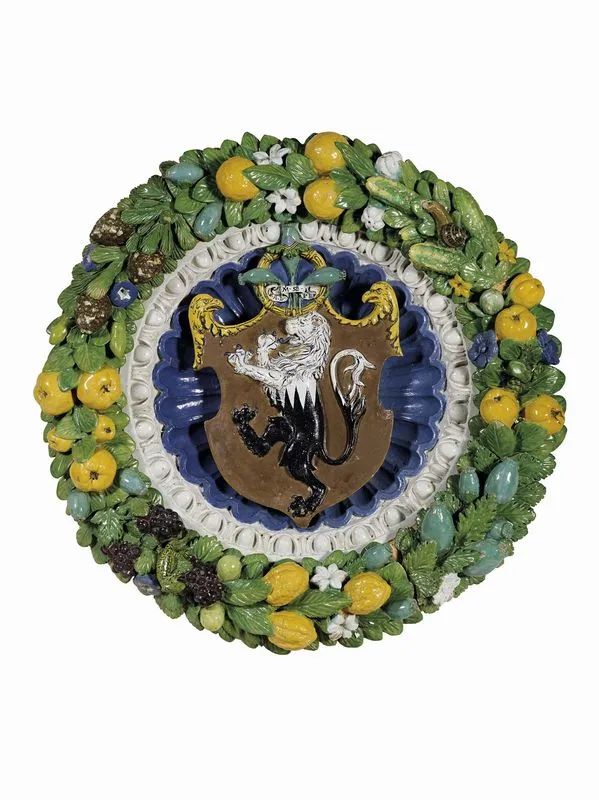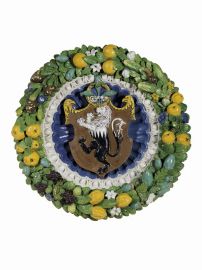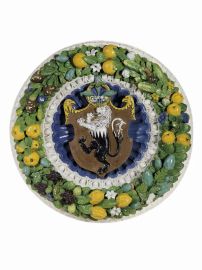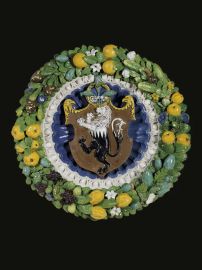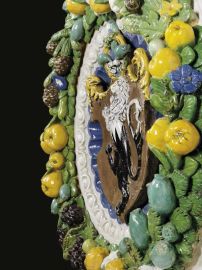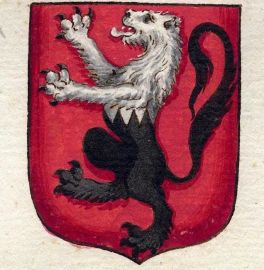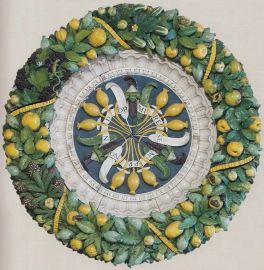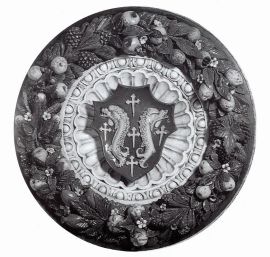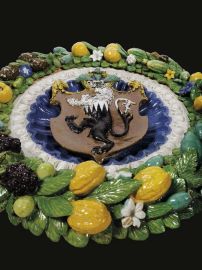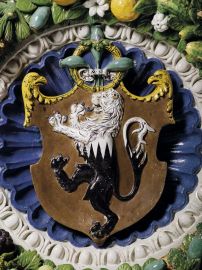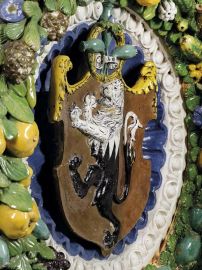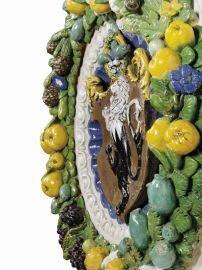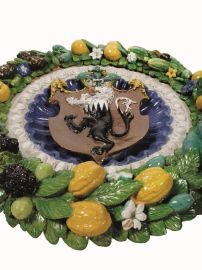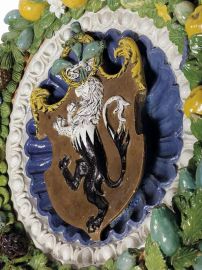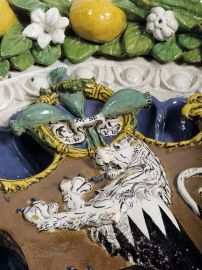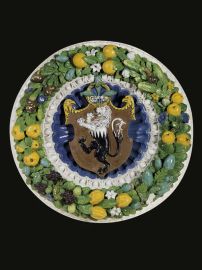Giovanni della Robbia
(Florence 1469 - 1529/1530)
COAT OF ARMS AND CREST OF THE BARTOLINI (BARTOLINI SALIMBENI) FAMILY, SURROUNDED BY A GARLAND OF FRUIT, FOLIAGE AND FLOWERS WITH SMALL ANIMALS, CIRCA 1520
A polychrome tin-glazed terracotta medallion; garland diam. cm 85; bowl diam. cm 58
Provenance
Florence, Bartolini Salimbeni family (from the Casino di Gualfonda?);
Ansbach, Georg Ebert Collection (ante 1956);
Milan, private collection?;
Würzburg, Peter Lockner Collection, inherited by his son Richard Lockner (between 1970 circa and 2005);
Munich, Hampel Fine Art Auctions (23 September 2005, lot 322);
Italy, private collection
Literature
R. Dionigi (a cura di), Stemmi robbiani in Italia e nel mondo. Per un catalogo araldico, storico e artistico, Firenze 2014, p. 113 n. 29
Comparative literature
Idelfonso di San Luigi, Istoria genealogica delle famiglie de’Salimbeni di Siena e de’ marchesi Bartolini Salimbeni di Firenze, in Del Magnifico Lorenzo de’ Medici, cronica scritta dal senatore Gherardo Bartolini Salimbeni, colla storia genealogica di questa illustre casata, Firenze 1786, pp. 81-434;
E. Ceramelli Papiani, Raccolta. Blasoni delle famiglie toscane, ms. sec. XX, Archivio di Stato di Firenze;
A. Marquand, Robbia Heraldry, Princeton 1919;
A. Marquand, Giovanni della Robbia, Princeton 1920;
L. Ginori Lisci, Gualfonda. Una antico palazzo ed un giardino scomparso, Firenze 1953;
L. Ginori Lisci, I palazzi di Firenze nella storia e nell’arte, 2 voll., Firenze 1972;
R. A. Goldthwaite, The Building of Renaissance Florence. An Economic and Social History, Baltimore - London 1980;
D. Gallo, Iacopo Sansovino, il Bacco e la sua fortuna, Firenze 1986;
R. Ciabani, Le famiglie di Firenze, 4 voll., Firenze 1992;
G. Gentilini, I Della Robbia. La scultura invetriata nel Rinascimento, 2 voll., Firenze 1992;
M. Vannucci, Le grandi famiglie di Firenze, Roma 1994;
M. Lingohr, Der Florentiner Palastbau der Hochrenaissance. Der Palazzo Bartolini Salimbeni in seinem historischen und architekturgeschichtlichen Kontext, Worms 1997;
I Della Robbia e l’“arte nuova” della scultura invetriata, catalogo della mostra (Fiesole, Basilica di Sant’Alessandro, 29 maggio - 1 novembre 1998), a cura di G. Gentilini, Firenze 1998;
F. Quinterio, Natura e architettura nella bottega robbiana, Ivi, pp. 57-85;
M. G. Vaccari, Tecniche e metodi di lavorazione, Ivi, pp. 97-116;
M. Mangiavacchi - E. Pacini, Arte e natura in Toscana. Gli elementi naturalistici e il paesaggio negli artisti dal Trecento al Cinquecento, Pisa 2002;
I Della Robbia. Il dialogo tra le Arti nel Rinascimento, catalogo della mostra (Arezzo, Museo Statale d’Arte Medievale e Moderna, 21 febbraio - 7 giugno 2009), a cura di G. Gentilini, Milano 2009;
G. Gentilini, T. Mozzati, “Naturalia” e “mirabilia” nell’ornato architettonico e nell’arredo domestico, Ivi, pp. 144-151;
M. G. Vaccari, Le robbiane. Appunti sulla tecnica e sugli aspetti commerciali, Ivi, pp. 76-85;
S. Salomone, Il Casino di Gualfonda a Firenze. “Il decoro della casa e la piacevolezza della villa”, tesi di dottorato in Storia dell’Architettura e dell’Urbanistica, Università di Firenze, 2011
Surrounded by a richly decorated garland, full of fruits and flowers and interspersed with small animals, this sophisticated and elegant coat of arms, resulting from a highly skilled craftsmanship, is surmounted by the crest of the family, which stands out from a precious and finely gadrooned bowl in the deep blue colour of lapis lazuli and is enframed within a thick moulded frame. This work and, in particular, the patronage of the Bartolini family during the Florentine Renaissance, contributed to identifying this refined medallion as one of the most valuable works of the vast heraldic production of Della Robbia in private collections.
As is well-known, coats of arms and heraldic ornaments played a special role in the vast tin-glazed terracotta production of Della Robbia, jealously handed down for over a century in the Florentine workshop of Via Guelfa through the commitment of three generations: Luca - sculptor, celebrated by the contemporaries as one of the pioneers of Renaissance style -, his prolific nephew Andrea and his five sons, Marco, Giovanni, Luca 'the Young', Francesco and Girolamo (Gentilini 1992, I Della Robbia 1998, Idem 2009). The production of works in enamelled terracotta painted with brilliant and long-lasting polychrome pigments guaranteed a very effective and, above all, constant representation of the coats of arms. In fact, thanks to the graceful and elegant ability to create garlands enriched with all the gifts of nature - similar to the realistic decorations of the classical artists described by Plinius (Gentilini - Mozzati 2009) -, the coats of arms of Della Robbia soon became very famous and were considered one of the most representative and appreciated artistic expressions of Della Robbia. This is testified by numerous publications on the production of Della Robbia written by scholars such as Allan Marquand (1919) or more recently, Renzo Dionigi (2014). Dionigi also identified the work that we are presenting here, attributed to Giovanni della Robbia and dated around 1520 (Dionigi 2014, p. 113, no. 29).
Having been out of view for quite a few decades, this coat of arms, which reappeared in 2005 on the international art market (Munich, Hampel Fine Art Auctions, 23rd September 2005, lot 322) and then passed to an Italian private collection, is well documented in one of the mid-twentieth-century photos and is ascribed to Giovanni. One of these photos, at the Zeri Foundation in Bologna, seems to suggest that this work passed through a private collection in Milan, while another one, held in the photographic archive of the Kunsthistorisches Institut in Florence, suggests that it belonged to the Georg Ebert Collection in Ansbach (1885 - 1956). Some letters allow us to establish that until 2005, this work was in Würzburg for about thirty-five years in the collection of a well-known art dealer, Peter Lockner (1936 - 2002/3) and was then inherited by his son Richard.
The coat of arms of the Bartolini Salimbeni family presents "a silver and black lion on a red shield-form background" (Ceramelli Papiani, sec. XX, fasc. 445): the red colour, absent in the palette of Della Robbia is replaced by a brown shade, while silver is replaced by the white colour, according to the heraldic rules. This lively rampant lion, represented as 'flattened', and characterized in its muzzle and thick mane by vibrant black enamelled strokes, is depicted in the centre of a very elegant and refined moulded shield. The two lateral ends of the shield are embellished with threatening eagle's heads whose feathers cover the edge and with a yellow glazed decoration recalling a golden ornament. In the central part of the shield the traditional crest of the family is replaced by the de' Medici diamond ring with the gem encircled by green leaves and crossed by three poppy seeds tied together with a ribbon inscribed with the motto “P(ER). N(ON). D.O.(R)M(IRE). SE.(M)PER” (For not sleeping).
This emblem symbolizes the vigilant, laborious and diligent commitment of this important wealthy Florentine family, that moved from Siena at the beginning of the 14th century to trade on wool (the original Salimbeni surname, later changed to Bartolini, was resumed around the half of the seventeenth century). It is said that a Bartolini concluded a particularly lucrative deal after giving his rivals sleeping substances, like poppy seeds, during a banquet. The eagles, not often represented in the heraldic production of Della Robbia and traditionally recalling the evangelist John, may, instead, refer to Giovanni Bartolini who commissioned the work and was one of the most prestigious and refined patrons of the Florentine Renaissance (Ildefonso di San Luigi 1786; Ciabani 1992, III, pp. 634-636; Vannucci 2006).
The coat of arms stands out from the gadrooned bowl, enamelled in deep blue to simulate the precious lapis lazuli stones, and is embedded within a 'band' frame inside a moulded egg-and-dart inner border, glazed in white to resemble marble, and covered in the centre by the crest with a refined space solution. The diameter of the bowl is one Florentine braccio, that of the frame one and a half braccia. The medallion is framed by a copious, colourful garland with foliage which combines the classical motifs with a renovated modern style. This abundant wreath, characteristic of the renown Della Robbia production (Quinterio 1998; Mangiavacchi - Pacini 2002, pp. 172-179, 182, 204-206), is infact interspersed with a wide variety of fruits (oranges, pine cones, quinces, black grapes, figs, citrons) and vegetables (broad beans, cucumbers, garlic bulbs), each with its specific foliage and flowers, alternated with numerous poppy seeds - with their heraldic significance - and with other white and light blue small flowers (bellflowers, wild roses, jasmines ?). Hidden among the leaves three small animals appear: a sinuous lizard, a tiny frog and a snail coming out of its shell - probably shaped using real animals following a recurring technique in the works of Giovanni della Robbia, as described in the short treaty of Cennino Cennini (about 1400) and well attested in the bronze and terracotta sculptures of the Florentine Renaissance, that later inspired the production and diffusion of the extravagant 'rustic' pottery of Bernard Palissy in the middle of the sixteenth century.
The composition of this garland, developed counter-clockwise, follows a precise regular structure in accordance with the geometric mathematical criteria theorized by Leon Battista Alberti (1436) that focused on a "varietas" regulated by the "compositio". The fruits of larger dimensions are in fact placed together in eight bunches, each consisting of three fruits of the same species to form a triangle in order to combine citrus fruits (oranges, citrons) and yellow fruits (quinces) with other elements with deeper colours (pine cones, black grapes, poppy seeds, cucumbers). In addition, two symmetrical pairs of flowers (mainly those of the specific fruit) are added to each bunch together with smaller flowers of various colours.
The formal compositional rigour of this garland - a feature that characterizes the best works of Della Robbia distinguishing them from other works of artists such as Benedetto and Santi Buglioni - is reflected in the technical craftsmanship of this medallion, resulting from the established practice of this artist and, in particular, in his ability to slowly dry, fire and transport the terracotta work (Vaccari 1998; 2009). The medallion is in fact made up of seven pieces: the shield, the moulded bowl and the wreath divided into four segments (each containing two groups of fruits). Carefully emptied in order to give to the clay a thin and uniform aspect, these elements were hollow on the back with a box-like structure and reinforced with a supportive framework and air holes behind the larger fruits, which were shaped by adhering the clay to the band of the frame.
Following the above-mentioned heraldic elements, this work probably dates around 1520 as suggested, as we will see, by the type of shield and of wreath and by some documents that testify the long-standing and refined patronage of Giovanni Bartolomeo di Leonardo Bartolini (1472 - 1544). Passionate "builder", also on behalf of his four brothers - Gherardo, Lorenzo, Zanobi, Cassandra -, Giovanni commissioned to Baccio d'Agnolo, between 1520 and 1523, the innovative, elegant palace overlooking the church of Santa Trinita (Ginori Lisci 1972, pp. 171-178, no. 13; Lingohr 1997), after having enlarged around 1500 the family palaces in Porta Rossa by incorporating the Monaldi Tower (Ginori Lisci 1972, pp. 169 -170, no. 12), and having restored the ancient 'Palagio dei Pini' purchased in 1493 in Rovezzano (today Villa Favard). Between 1507 and 1525, Giovanni also built the so-called "Casino of Delight" of Gualfonda (or Valfonda Palace) with its vast, magnificent garden extending near the city walls in the area now occupied by Santa Maria Novella Train Station (Gomori Lisci 1953; Idem 1972, pp. 317-322, no. 42; Salomone 2011). Probably constructed by the same architect, these buildings were surmounted by the same crest and motto that we find in our medallion.
The accounting books of Giovanni Bartolini (held today in the archives of Bartolini Salimbeni Vivai in Villa di Collina near Vicchio di Mugello, of which partial excerpts are mentioned in this bibliography) confirm the privileged relationship with Della Robbia. In these books are also recorded the numerous and famous artists - Lorenzetto, Tribolo, il Cicilia, Nanni Unghero, Francesco and Giovanni del Tasso, Andrea Feltrini, Alonso Berruguete and others - who contributed to the furnishings of these dwellings. Among them, it is worth noting the young Jacopo Sansovino who, as Vasari stated, created the famous marble Baccus for Gualfonda in 1510-12, held today in the National Museum of Bargello, that stands on a lost base carved by Benedetto da Rovezzano in 1519 (Gallo 1986).
In 1521 (or in 1523, according to Goldthwaite 1980, p. 403, note 10), "Luca d'Andrea", or Luca della Robbia 'the Young' (Florence 1475 - Paris 1548), Giovanni's younger brother, was paid six fiorini - a triple price in comparison to what was usually paid to Della Robbia for the renown podestà family crests - for a "garland and a glazed coat of arms for the ground-floor room of the Church of Santa Trinita", and also for a "tondo with foliage to adorn the loggia's vault" (Ginori Lisci 1972, pp. 175, 178 note 8). The medallions embellished by two garlands with the crest of the Bartolini family were identified as belonging to the collection of Marquis Luigi Torrigiani in 1861: one of them with its magnificent coat of arms passed to the Museum of Bargello in 1939, while the other was probably disassembled by the previous owners. Of this marvellous masterpiece of Della Robbia, only a more modest version is known at the Musée National de la Renaissance in Écouen (Gentilini 1992, pp. 333-334, 370 note 33-3, Dionigi 2014, p.175 no.146, p.144 no. 98).
In 1520, Andrea della Robbia acted as mediator on behalf of an unspecified "friend" for the payment of "a bronze child on a dolphin" destined to the Bartolini Palace of Santa Trinita (Ginori Lisci 1972, p. 178 note 9); this subject was also reproduced in a famous tin-glazed terracotta (previously in London, Alex Wengraf Ltd.) attributed to Giovanni della Robbia (F. Domestici in I Della Robbia 1998, pp. 269-270, III.12). In March of the previous year, Giovanni had already received a down payment through his "brother", for "a child," perhaps a putto or a spiritello (a winged infant of a sprite), to embellish a fountain in the Casino di Gualfonda (Ginori Lisci 1953, pp. 10, 22, note 12, Idem 1972, pp. 318, 322, note 5). An involvement that can thus confirm the attribution and dating of our coat of arms, and suggests, albeit cautiously, that it was originally destined to the same building.
In addition, all the elements that characterise this medallion, like the copious decoration of the garland with its richly decorated fruits and leaves and its lively small animals, the moulded shape of the shield with raised sides, the refined coat of arms and the niche in the background, painted with brilliant enamel pigments, and the details outlined by black strokes, contribute to ascribing this work, dated around 1520, to Giovanni della Robbia. These features are also confirmed by the numerous and famous works signed or documented, among which the innovative Tabernacle of Fonticine located along Via Nazionale in Florence, dating back to 1522 (Marquand 1920, Gentilini 1992, pp. 279-238). And even more significant evidence emerges from the rich heraldic production attributed to Giovanni, such as the sumptuous coats of arms of the Pazzi and Del Monte families in the Contini Bonacossi Collection and today at the Uffizi, the Minerbetti coat of arms in the Metropolitan Museum of Art of New York or the numerous heraldic examples of coats of arms still preserved on the facades of the most important palaces of Florence, that can therefore be dated with certainty, such as the coat of arms of Andrea Particini at Pieve Santo Stefano (1516), that of Bernardo de' Medici at Certaldo (1519) or that of Bindaccio Ricasoli (1514) and Lorenzo Lapi (1526) at Scarperia (Dionigi 2014, p.128, no. 64, p.169, no. 137, p.170, no. 138, p.225, no. 237, p. 290, no. 378, p. 294, no. 384).
Giovanni was in fact the most independent and prolific artist among the sons of Andrea who worked together in the workshop in Via Guelfa until their father's death in 1525. Giovanni's works - which were the only works sometimes signed by the artist - distinguish themselves among the vast koinè of the Della Robbia production of the first half of the sixteenth century for a more distinctive and original decoration which reflect a classical and naturalistic style.
Giancarlo Gentilini
Florence, August 28th, 2017

